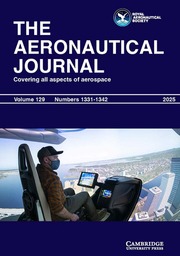Article contents
Optimal load limiting parachute inflationcontrol
Published online by Cambridge University Press: 04 July 2016
Abstract
Excessive deceleration forces experienced during highspeed deployment of parachute systems can causedamage to the payload and the canopy fabric.Conventional reefing lines offer limited relief bytemporarily restricting canopy inflation andlimiting the peak deceleration load. However, theopen-loop control provided by existing reefingdevices restricts their use to a specific set ofdeployment conditions. The sensing, processing, andactuation which are characteristic of adaptivestructures form the basis of three concepts foractive control of parachute inflation. These activecontrol concepts are incorporated into a computersimulation of parachute inflation. Initialinvestigations indicate that these concepts promiseenhanced performance as compared to conventionaltechniques for a nominal release. Furthermore, theability of each controller to adapt to off-nominalrelease conditions is examined.
Information
- Type
- Research Article
- Information
- Copyright
- Copyright © Royal Aeronautical Society 1995
References
- 3
- Cited by

